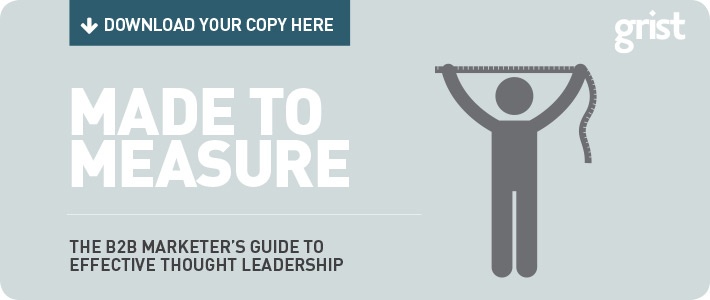It’s no use throwing good money after bad content. These three questions will help you refocus your B2B content marketing strategy on quality, not quantity.
First the good news. According to the Content Marketing Institute, most firms spend over a quarter of their marketing budget (28%) on words, graphics and moving pictures. It’s a vote of confidence for those who believe in the power of great content.
Now the bad news. Much of the money is wasted on ill-conceived and poorly executed campaigns. Even when some metrics suggest success – increase in output, page impression growth, downloads on the up – it turns out that sales, that ultimate key performance indicator, remain stubbornly unchanged.
And if the sales team is unhappy, the B2B marketer is too. Where 38% of B2B marketers believed they were doing an effective job in 2014, a year later only 30% thought that was the case, their faith in content marketing shaken.
Struggling to identify why the money and effort is making little difference? Then go back to basics and address the following three questions.
1. Why do you produce content?
Questions don’t come more basic than this. When asked, many firms struggle to come up with a coherent answer beyond, ‘It’s what we’ve always done’, ‘It’s part of the marketing mix’, ‘Our competitors do it, so we should too’ or ‘People would notice if we stopped’.
It may come as a shock but the world isn’t waiting for your next piece of content. Words without purpose rarely generate interest.
Content must have a mission, an objective that reflects business goals. That doesn’t mean writing about how wonderful your products or services are but it does mean defining differentiation, or taking the ‘What do we want to be famous for?’ test. In a competitive landscape – where some rivals will have greater resources to draw on – that means going to your niche and articulating a content mission to match.
Prioritising certain sectors or themes means accepting that other areas will be downplayed. And that’s fine. It’s key to the strategy, bringing clarity to your offer and to your message.
2. Do you (really) know what your clients want?
Knowing what your organisation wants is only half of the equation, of course. Knowing what your clients want is the other half. It means asking them and observing how they interact with the content you already provide to assess what works and what doesn’t.
Knowing what your clients want is not just about listing their topics of interest. It’s about understanding the challenges they face, their changing needs across the buying cycle, their circles of influence, the formats they prefer and even the days of the week and times of day they seek out the type of content you might provide.
Our Value of B2B Thought Leadership survey looked at the wants and needs of the C-suite working in FTSE 350 companies. Some of the results might surprise – such as a preference for short-form, text-based articles over video and other multimedia bells and whistles – but the underlying message ought to come as no surprise. Senior executives want thought leadership that helps them stay ahead of emerging trends (66%) and helps them make better, more informed decisions (60%). Does your content deliver on either? If not, rewrite, recommission, rethink.
3. Do you know where content fits into the business development process?
In fact, there’s a more fundamental question that precedes this one – do you fully understand the business development process? If not, it’s time to find out and then apply the content marketing strategy to it.
This means thinking about what information your audience might need at any given stage, and creating and signposting helpful content that anticipates and answers their most pressing questions. If crucial links in this chain are missing or broken, the likelihood is they will look elsewhere.
Marketing facilitates a dialogue between those that sell and those that buy. In that context, content should be a major engagement tool, albeit not the only one. Get the narrative and the timing right and you can shorten and strengthen the B2B buyer journey.
Without addressing these three questions, your content will never do what you want it to do.
Find out more about creating content with purpose in our Guide to Content Marketing Strategy for Professional Services Firms



